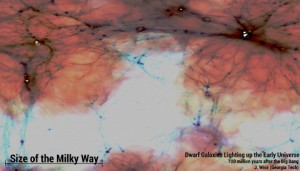Light from the puniest galaxies played a bigger role in shaping the early universe than previously thought.

highlighted in white.
J. Wise
Today, we tend to see dwarf galaxies clinging to the skirts of larger galaxies, or strung out in debris streams engulfed within their larger counterparts. But new observations show that these small, unassuming galaxies played a larger role in creating the conditions in the universe we know today than previously thought.
Right after its birth, the young universe was filled with a hot, dense fog of ionized gas. And for hundreds of thousands of years the universe was too hot to handle anything else. But over time it expanded and cooled, allowing electrons and protons to recombine into neutral atoms.
Giant clouds of these primordial elements collapsed to form the first stars, whose ultraviolet rays heated the surrounding medium, once again stripping the hydrogen of its electrons in the epoch of reionization. This epoch marked the last major change in the early cosmos’s makeup, as the universe remains ionized today.
But astronomers face two questions: what were the main instigators behind reionization, and when did it happen?
Studies of distant quasars — brilliant beacons created by supermassive black holes rapidly accreting material — suggest the universe became fully reionized roughly one billion years after the Big Bang. On the other hand, studies from the cosmic microwave background (CMB) — the radiation released 380,000 years after the Big Bang — suggest the universe was 50% ionized around 400 million years after the Big Bang.
Although these two observations may not seem to contradict one another, astronomers have had no luck in recreating both in one coherent model. “For the last decade, there has been some tension between [the] two sets of observations,” says study coauthor John Wise (Georgia Institute of Technology).
Wise and colleagues attacked the mystery by using advanced computer simulations to create their own mini-universe. By unleashing a range of physical processes — from the expansion of the universe to the chemical reactions of hydrogen and helium — within their model, they recreated the conditions that likely occurred during the epoch of reionization.
The team found that researchers have wrongly overlooked the role dwarf galaxies — galaxies 1000 times smaller in mass and 30 times smaller in size than our own Milky Way galaxy — played in the early cosmos.
The new study shows that dwarf galaxies contributed nearly 30% of the ultraviolet light during the process of reionization. The dwarfs had such a big impact because a larger fraction of ionizing photons are able to escape dwarf galaxies (clocking in at 50%) as opposed to larger galaxies (clocking in at a mere 5%).
Pinning Down a Cosmic Timeline
Although 30% may not seem like a significant number, before this study the smallest dwarf galaxies weren't even thought to form stars, let alone allow so much ultraviolet light to escape into the surrounding medium. Astronomers thought that the radiation from stars in the nearby, larger galaxies was so strong that it would suppress their tiny neighbors.
So previous studies just assumed that all galaxies were the same size and released the same amount of light. But Wise and colleagues found that dwarf galaxies could form stars, if they did so before larger galaxies began to dominate.
“The answer Wise provides is the formation of very low mass galaxies that are up to 10 magnitudes fainter than the faintest objects found in the Hubble Ultra Deep Field,” says expert Brant Robertson (University of Arizona).
So the team’s simulation naturally provides a gradual timeline that tracks the progress of reionization over hundreds of millions of years.
“The smallest galaxies first dominate at early times; however, they basically kill themselves off by blowing out their gas through their own supernovae and heating their environment,” says Wise. “Afterwards, larger galaxies (but still much smaller than the Milky Way by about 100 times in mass) take over the job of reionizing the universe.”
This result fits nicely with other simulation studies, which suggest that dwarf galaxies quickly shut off their star formation thanks to the heating effect of their own stars’ radiation, ultimately adopting an on-again-off-again cycle of star formation.
Wise’s team found that the universe was fully ionized at 860 million years after the Big Bang, which fits with both the quasar and CMB results.
“As a theorist, I applaud their efforts as they have included a lot of the relevant physics necessary to describe the reionization process,” says Robertson. He does however caution that many of the simulation’s results, particularly dwarf galaxies forming in the first billion years of the universe, might never be confirmable because we can’t directly observe these predictions.
But that’s the nature of the game. The team hopes to better constrain the simulated results in the future as next-gen telescopes enable more accurate observations of the CMB and neutral hydrogen during the epoch of reionization.
J. Wise
Reference:
John H. Wise et al. “The Birth of a Galaxy — III. Propelling Reionization With the Faintest Galaxies” Monthly Notices of the Royal Astronomical Society, August 11, 2014
 1
1









Comments
Justin S
July 25, 2014 at 7:49 am
The top illustration looks better with the colors inverted.
You must be logged in to post a comment.
You must be logged in to post a comment.